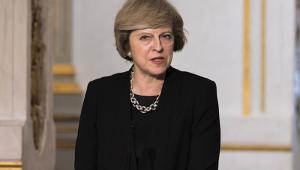Conference speeches are rarely game changers. Every politician wants theirs to be; every party leader’s spin team claims their one has been; they are all written up as if they might be – but very few actually are. Theresa May’s speech just might have been. It was light on policy, but in 7,000 words the new prime minister outlined a political project that she hopes will carry the nation into the post-Brexit era.
May’s strategy was simple, yet audacious. She simultaneously pitched herself as the backbone of the Brexit movement, while firmly planting her flag on the centre ground of politics. While her refrain that “a change has got to come” brought to mind the UK’s new relationship with the European Union, it also pointed to something deeper at the heart of the new government. The change she was referring to was also a change from the recent past. As conference delegates applauded David Cameron’s successes, his replacement was firmly drawing a line under his time in office. Just a year after a general election which brought the Conservatives their first Commons majority in decades, Theresa May has already set out to put her party and her government on a radically new path.
This new direction seems set to put May at odds with both the left and with the more libertarian wing of her own party. On Brexit, she wanted to present the government as having a clear plan for the future. The speech promised British business a place in the single market as well as continuing co-operation with Europe on issues like crime and counter-terrorism. However, it has been clear this week that May’s major concern is controlling immigration. Promising to clamp down on the number of people coming to the UK, whether they are low paid workers, students, or even doctors, has gone from a vague aspiration to being the Conservative’s central message. While this clamp down might draw outrage from some, May is gambling that a more hard line stance will be the best way to win the hearts of both Conservative voters and UKIP voters who voted Leave in June. What is less clear is why the EU would accept this arrangement. Brexit has often been seen as a choice between the single market and controlled immigration. How May can square this circle will be fundamentally important for the government in the Brexit negotiations.
However, it is clear that the main difference between May, her predecessor and perhaps her party will be on the economy. Unlike Cameron, and any Conservative leader since the 1970s, the beating heart of the May project is a greater role for the state. Free from the constraints imposed by Brussels, her government intends to intervene much more widely in the British economy. This might not mean “picking winners”, but it does mean “policies on trade, tax, infrastructure, skills, training, and research and development”. Echoing the chancellor’s speech a few days earlier, May also made clear that boosting productivity will be at the heart of a new economic strategy, along with a renewed commitment to the devolution agenda.
That isn’t all that’s on May’s economic agenda though. She wants to go further and deliver on pledges made during the leadership campaign to clamp down on tax avoidance by businesses, increase workers’ representation on company boards and to tackle the high cost of energy and other utility bills. We also appear to be edging closer to a favourable decision for Heathrow, another major infrastructure project that could get signed off by the government after it backed both HS2 and the new Hinkley Point development. Despite George Osborne’s fondness for a building site and a day-glo jacket, the Cameron regime typically shied away from backing these projects. By contrast, May wants to be seen to deliver.
Whether Theresa May’s policy will match her lofty ambition is anyone’s guess. But if this speech proved one thing, it’s that the May government is bad news for Jeremy Corbyn’s Labour. Polling shows immigration is a major issue for all voters, including those who backed Labour in 2015, and Corbyn appears unwilling to even discuss it. Likewise Brexit: May’s plans may prove unworkable, but at least she appeared to have one. Labour didn’t even debate the issue at its conference. The Conservatives have also stolen some of the most popular, or populist, elements of recent Labour policy. A utility price freeze and worker representation is straight out of the Ed Miliband playbook. May’s plans for greater state intervention has stolen a march on even the most left-wing of Labour figures, but presented these ideas with a veneer of competence and capability that most Labour figures could only dream of their party possessing. If you were a Labour MP facing a tough general election battle, May’s speech would have you feeling deeply, deeply, troubled.
A radically different vision then, from a radically different prime minister. May clearly sees Brexit as an opportunity for major reform, but one question remains: is this vision enough on its own to see May through to 2020, or will she be tempted to put it to the test before then? Such a departure from the policy and style of David Cameron might leave a door open to an early general election. Will Theresa take it?



















